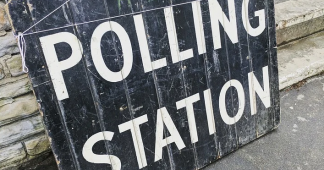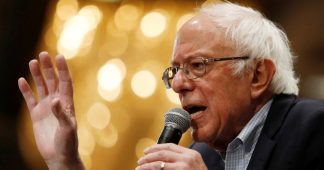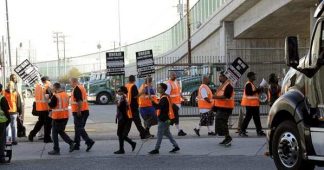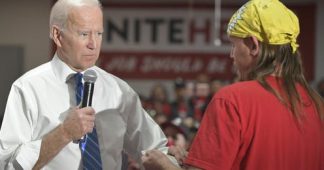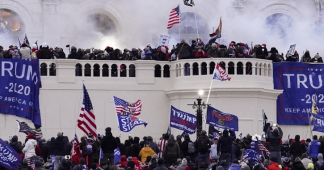By Alex N. Press
Jan. 8, 2021
On Wednesday, as Donald Trump supporters stormed the US Capitol, a statement was issued from an unexpected quarter. “Manufacturers Call on Armed Thugs to Cease Violence at Capitol,” reads the document, published by the National Association of Manufacturers (NAM).
NAM represents around fourteen thousand manufacturers. Representatives of ExxonMobil and Pfizer Inc. serve on the current executive committee, while board members include representatives of General Electric, Raytheon Technologies, General Motors, Boeing, and Smithfield Foods. It’s a lobbying group — Open Secrets reports it spent nearly $15 million on lobbying in 2019 — but not just any lobbying group. While the policy preferences of the average person in the United States may have little to no bearing on public policy, organizations like NAM ensure capitalists’ preferences are taken into account. If the executive of the modern state is but a committee for managing the common affairs of the whole bourgeoisie, it’s in large part thanks to organizations like NAM.
On Wednesday, NAM’s statement quickly gained a wide audience. Anyone watching CNN that evening heard several references to it. However, no one said much about the organization itself. Which is too bad, because few groups have a more storied history of waging war on democracy.
A Shadow Over the Labor Movement
Founded in 1895 in response to a wave of labor organizing, NAM has a long history of fighting one of the country’s key democratic institutions: unions.
Its early years were devoted to goals such as lobbying over tariffs and creating a US Chamber of Commerce. But while organizing the capitalist class, the group never took its eyes off the enemy. Organized labor would bring about “despotism, tyranny, and slavery,” NAM president David Maclean Parry declared at the group’s 1903 convention. (Not long afterward, Parry published The Scarlet Empire, a dystopian novel about a socialist society — despite the creative possibilities afforded to the fiction writer, his society, Atlantis, even has a “Federation of Labor of Atlantis. As you can imagine, the federation turns totalitarian, dominating society at large with its oppressive egalitarianism.) As John Kirby Jr, the organization’s new president, put it at the 1911 convention, one-upping Parry, “The American Federation of Labor is engaged in open warfare against Jesus Christ and his cause.”
While NAM met with some success in the early twentieth century, the Great Depression changed all that. Franklin D. Roosevelt’s election and the passage in 1935 of the National Labor Relations Act (NLRA) called for a new business strategy. The NLRA guaranteed workers’ right to join a union. While many capitalists, including NAM, hoped the law would be overturned by the Supreme Court, in 1937 the justices upheld it. Unions grew at an unprecedented rate. It was the year of the Flint, Michigan sit-down strike at General Motors: in a six-month period, the Congress of Industrial Organizations (CIO) gained two million members.
In response, NAM got busy on the propaganda front, pioneering a red-baiting strategy against labor that, in the long run, helped to severely hobble the movement. At the time, the majority of the organization’s budget was allocated to public relations. Through its National Industrial Information Council, it circulated millions of copies of cartoons, pro-business newspaper columns, a film series, and some forty-five thousand billboards.
For instance, in 1938 NAM printed and distributed millions of copies of a pamphlet with a cover depicting miners union leader John L. Lewis — the enormous bushy eyebrows are impossible to mistake — holding a picket sign that reads “Join the CIO and Help Build Soviet America.” The pamphlet quickly found its way into mass production plants.
The late 1930s also saw NAM take to radio. One show produced by the group, “The American Family Robinson,” which followed a family led by a benevolent capitalist patriarch, featured a plot didactically engineered to promote free enterprise. (A whimsical brother prone to socialist tendencies provided an opportunity to dramatize the silliness and danger of socialism, not unlike Parry’s The Scarlet Empire).
Despite these efforts, working-class organizations continued to grow. While the Second World War muted the class war, its end saw a doubling down of militancy across industries. Nearly 10 percent of the US workforce went on strike in 1946.
It was an explosion too large to ignore: business demanded a political response, and with a newly elected Republican majority in Congress, they got one. As Congressman Donald O’Toole of New York later said, the anti-union Taft-Hartley Act of 1947 was prepared “sentence by sentence, paragraph by paragraph, by the National Association of Manufacturers.” As Republican Joseph Ball of Minnesota told attendees of the 1946 NAM convention regarding the pending legislation, “It will bear down most heavily on unions.” Indeed, the bill, which sharply restricted workers’ rights while enshrining those of employers into law, continues to cast a shadow over the labor movement.
Over subsequent decades, NAM continued innovating its propaganda machine. In the 1950s, a NAM-produced television show was beamed into homes across the country: Industry on Parade highlighted various industries and the companies that led them, running fifteen minutes in length and including commentary on the desirability of the US’s capitalist system over the “Communist slave system,” as one episode on the aluminium industry puts it.
But NAM’s didn’t confine its work to propaganda. As Jeremy Millroy recounts in Blood, Sweat, and Fear: Violence at Work in the Auto Industry, 1960–80, NAM, taking a page from the Vietnam War playbook, held counterinsurgency seminars in Detroit in 1968, distributing six hundred thousand copies of a pamphlet titled “Industrial Planning Guide Against Civil Disorders.”
A Bright Future
More recently, NAM has enjoyed “unfettered access to the White House under Trump,” playing a central role in crafting the administration’s tax bill. Trump himself spoke at its 2017 convention, and during his term the organization hired several former administration officials as lobbyists. Less than a year ago, in February of 2020, it chose Ivanka Trump as the inaugural recipient of its Alexander Hamilton Award, an honor intended to recognize leaders “who, like Hamilton, inspire Americans to promote, perpetuate, and preserve manufacturing in America.”
NAM isn’t the only representative of big business that’s had a deleterious influence on democracy — nor is it the only brand with a less-than-spotless record that has issued statements on the events in Washington DC — but its inglorious history and close ties to the Trump administration puts its willingness to advise on democracy’s preservation in an especially ridiculous light. NAM, it seems, hasn’t lost its touch in matters of public relations — their widely reported press release conveniently cast the group as an ally of the incoming Democratic majority. In short, quite the coup
Published at jacobinmag.com
